Special Report
Best and Worst Run States in America: A Survey of All 50
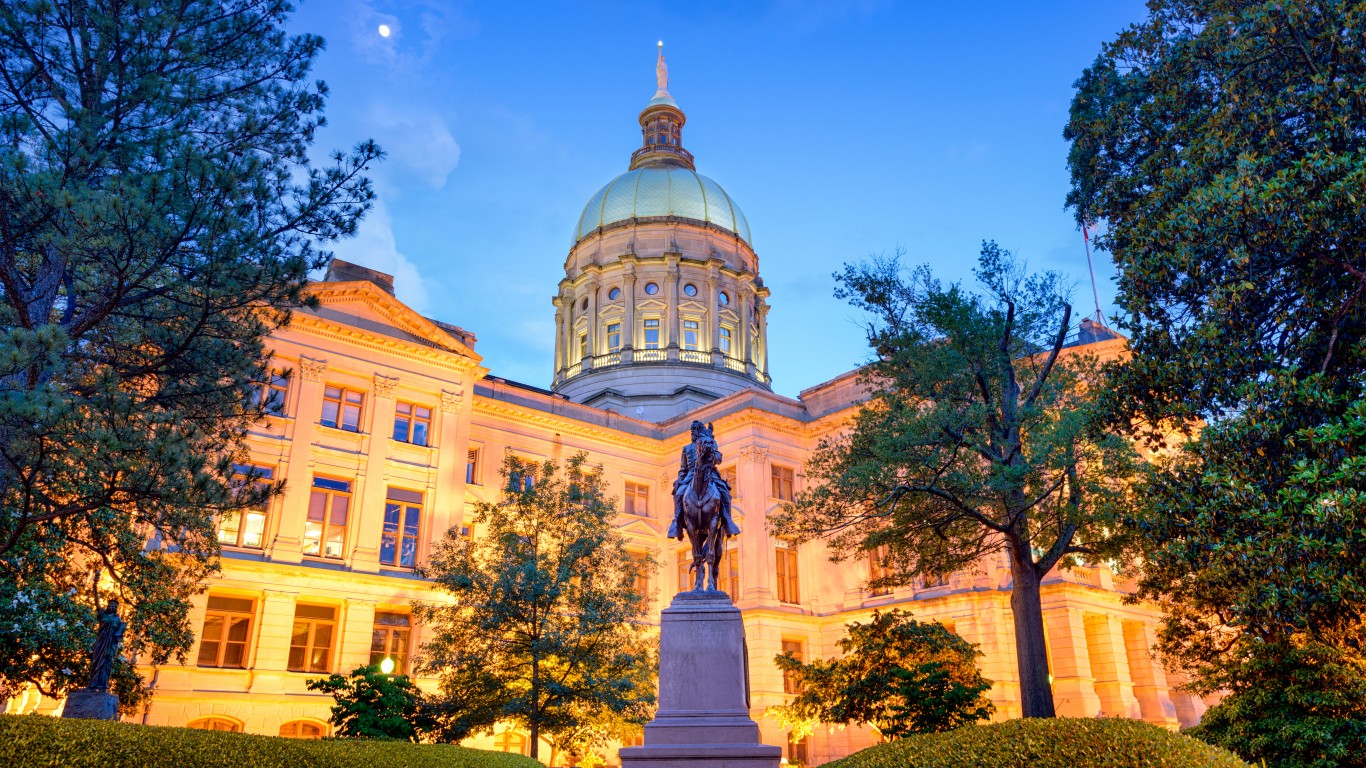
Published:
Last Updated:

The U.S. Constitution grants state governments a wide range of powers. Safe streets, a balanced budget, a strong job market, and a growing economy can all come as a result of strategic policy making at the state level. Some states have proven to be more adept than others at achieving these goals.
For the 10th year in a row, 24/7 Wall St. reviewed economic indicators, budget allocations, and state balance sheets, in addition to a range of social measures to rank how well each state is run. Data came from a wide range of public and private sources, including public policy think tank The Pew Charitable Trusts and the U.S. Census Bureau.
There are several signs of fiscal mismanagement at the state level, including minimal rainy day fund savings — funds set aside for budget emergencies — and less-than-perfect credit rating scores from ratings agencies. Another common theme among lower-ranking states on this list is an underfunded pension system. Many states are facing a crisis, with pension obligations far outweighing available funds. Here is a look at every state’s pension crisis, ranked.
It is important to note that current economic and social conditions in a given state are often not the result of the work of sitting elected officials. High-level governing strategies and budget priorities can have consequences that extend far beyond the tenure of those who make them. Additionally, some of these conditions are less the result of effective governing and more a product of geography and the presence of natural resources.
How well a state ranks on this list is not always an indication of the likelihood of a high quality of life for the typical resident. Indeed, many of the highest ranking states on this list do not rank among the best states to live in. Here is a full list of the best and worst states to live in.
Click here to see the best and worst run states in America: a survey of all 50
Click here to read our methodology

1. Utah
> 2018 unemployment: 3.1% (12th lowest)
> Pension funded ratio: 90.3% (7th highest)
> 1 yr. GDP growth: 3.7% (8th highest)
> Poverty rate: 9.0% (3rd lowest)
> Moody’s credit rating and outlook: Aaa/Stable
Based on an index of over a dozen socioeconomic measures, Utah ranks as the best-run state in the country. Over 92% of adults in Utah have a high school diploma or higher, one of the largest shares among states and well above the 88.3% national average. A well-educated population may be the result of greater investment, as 28.7% of Utah’s budget goes to schools, the largest share of any state.
Greater educational attainment often translates to greater employability, and in Utah only 3.1% of the labor force was out of a job in 2018, well below the 3.9% national unemployment rate. The state’s strong job market is also likely bolstered by rapid economic growth. Utah’s economy expanded by 3.7% in 2018, far outpacing the 2.9% national GDP growth.
[in-text-ad]

2. Washington
> 2018 unemployment: 4.5% (9th highest)
> Pension funded ratio: 89.6% (9th highest)
> 1 yr. GDP growth: 5.8% (the highest)
> Poverty rate: 10.3% (9th lowest)
> Moody’s credit rating and outlook: Aaa/Stable
Washington’s 5.8% GDP growth in 2018 was the highest of any state and nearly double the 2.9% national economic growth rate.
Like many of the best-run states, Washington’s population is growing rapidly. Between mid-2017 and mid-2018, the population grew by 1.5%, while nationwide the population grew by only 0.6% over the same period. People moving to the state accounted for the majority of the growth. The rapid population growth has likely contributed to higher home values because of higher demand for housing. Over the last year, the median home value in the state climbed over 10%, from $339,000 to $373,100, nearly double the 5.6% home value appreciation nationwide.

3. Minnesota
> 2018 unemployment: 2.9% (8th lowest)
> Pension funded ratio: 63.3% (15th lowest)
> 1 yr. GDP growth: 2.6% (16th highest)
> Poverty rate: 9.6% (6th lowest)
> Moody’s credit rating and outlook: Aa1/Stable
There were just 220 violent crimes for every 100,000 people in Minnesota in 2018, well below the 369 per 100,000 national violent crime rate. Low crime rates can be indicative not only of effective policing, but also of economic opportunity. In Minnesota, just 2.9% of the labor force was unemployed in 2018, well below the 3.9% national jobless rate.
The state’s strong job market likely partially explains the relatively small share of Minnesota residents facing serious financial hardship. Just 9.6% of the state population lives below the poverty line, one of the lowest poverty rates in the country and well below the 13.1% national rate.

4. Oregon
> 2018 unemployment: 4.2% (14th highest)
> Pension funded ratio: 83.1% (10th highest)
> 1 yr. GDP growth: 3.8% (7th highest)
> Poverty rate: 12.6% (25th lowest)
> Moody’s credit rating and outlook: Aa1/Stable
Oregon has one of the fastest growing economies in the United States. Last year, Oregon’s GDP expanded by 3.8%, well outpacing the comparable 2.9% growth nationwide. Additionally, while many states have woefully underfunded pension systems, Oregon is relatively well positioned to meet its pension payment obligations. According to the Pew Charitable Trusts, Oregon has funding for over 83% of its pension liabilities. For reference, the majority of states have less than 75% of their pension obligations funded.
Oregon is also a relatively safe state. There were just 286 violent crimes for every 100,000 state residents in 2018, well below the 369 per 100,000 national violent crime rate.
[in-text-ad-2]

5. Idaho
> 2018 unemployment: 2.8% (6th lowest)
> Pension funded ratio: 91.3% (5th highest)
> 1 yr. GDP growth: 4.0% (6th highest)
> Poverty rate: 11.8% (20th lowest)
> Moody’s credit rating and outlook: Aa1/Stable
Idaho, one of four Western states to rank among the top five on this list, has one of the strongest economies in the country by several measures. The state’s GDP expanded by 4.0% from 2017 to 2018, faster than in all but a handful of other states. Rapid economic growth can be indicative of an improving job market, and just 2.8% of the state’s labor force was out of a job in 2018, well below the 3.9% national unemployment rate.
Many states have woefully underfunded pension systems, but Idaho is relatively well positioned to meet its pension payment obligations. Idaho has funding for over 91% of its pension liabilities. Meanwhile, the majority of states have funding for less than 75% of their pension obligations.
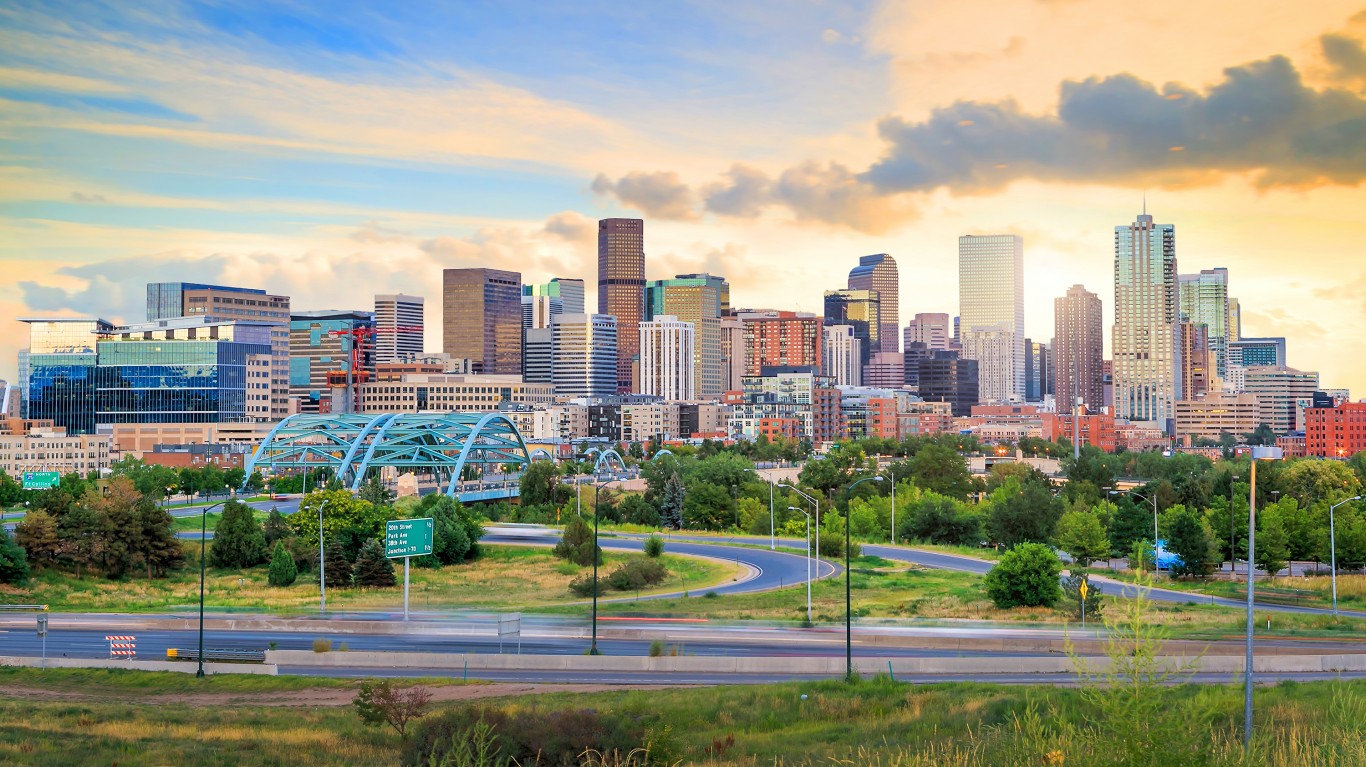
6. Colorado
> 2018 unemployment: 3.3% (14th lowest)
> Pension funded ratio: 47.1% (5th lowest)
> 1 yr. GDP growth: 3.5% (10th highest)
> Poverty rate: 9.6% (6th lowest)
> Moody’s credit rating and outlook: Aa1/Stable
Both income and job security tend to go up with educational attainment, and Colorado is one of the best-educated states in the country. Of all adults in the state, 91.9% have a high school diploma and 41.7% have a bachelor’s degree, well above the respective 88.3% and 32.6% national shares. Perhaps not surprisingly, financial hardship and joblessness are relatively rare in Colorado. Just 9.6% of the state population lives below the poverty line, and 3.3% of the labor force is out of a job, each well below the respective 13.1% and 3.9% national rates.
Largely due to net migration, Colorado’s population is growing faster than all but a handful of other states. Between 2017 and 2018, Colorado’s population grew by 1.4%, more than double the 0.6% national population growth rate.
[in-text-ad]

7. Iowa
> 2018 unemployment: 2.5% (2nd lowest)
> Pension funded ratio: 82.3% (12th highest)
> 1 yr. GDP growth: 2.2% (17th lowest)
> Poverty rate: 11.2% (18th lowest)
> Moody’s credit rating and outlook: Aaa/Stable
Iowa ranks as the second best-run state in the Midwest, after only Minnesota, and the seventh best ranked nationwide. Iowans benefit from one of the strongest job markets in the United States. Just 2.5% of the labor force in the state is out of a job, nearly the lowest unemployment rate in the country and well below the comparable 3.9% national rate. Many Americans have health insurance through their employers (or the employer of a family member), and Iowa’s low jobless rate may help explain the state’s low uninsured rate. Just 4.7% of state residents lack health insurance, compared to the national uninsured rate of 8.9%.
Iowa is also fiscally well managed. The state is one of only 15 with a perfect triple A rating and a stable outlook from Moody’s.
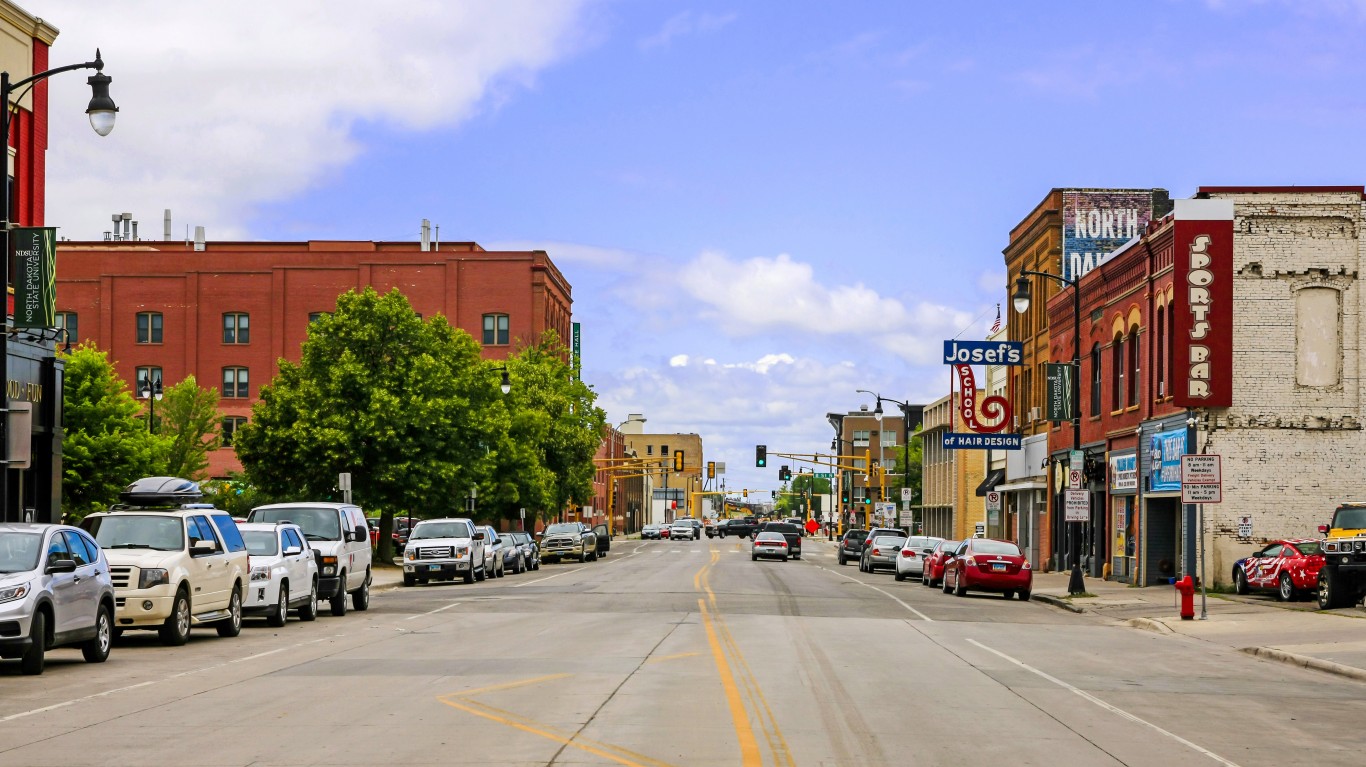
8. North Dakota
> 2018 unemployment: 2.6% (4th lowest)
> Pension funded ratio: 63.8% (16th lowest)
> 1 yr. GDP growth: 3.6% (9th highest)
> Poverty rate: 10.7% (11th lowest)
> Moody’s credit rating and outlook: Aa1/Stable
In the last decade, North Dakota has benefited from an economic and population boom due to natural gas and oil drilling in the western part of the state. Though growth has slowed slightly in recent years, North Dakota is still reporting faster than average GDP growth. From 2017 to 2018, the state’s economy expanded by 3.6%, more than all but eight other states and well above the 2.9% national GDP growth.
North Dakota is also a relatively safe state. There were just 281 violent crimes reported for every 100,000 state residents in 2018, far below the 369 per 100,000 national violent crime rate.

9. Texas
> 2018 unemployment: 3.9% (25th highest)
> Pension funded ratio: 76.1% (22nd highest)
> 1 yr. GDP growth: 4.0% (5th highest)
> Poverty rate: 14.9% (11th highest)
> Moody’s credit rating and outlook: Aaa/Stable
Texas has one of the fastest growing economies in the United States. In the last year, the GDP of Texas expanded by 4.0%, well above the comparable 2.9% national growth. Texas also has the equivalent of 19.7% of its annual budget saved in a rainy day fund, more than all but two other states. Fiscally well managed, Texas is one of only 15 states with a perfect triple A rating and a stable outlook from Moody’s.
Compared to other states, those that are fiscally well managed and otherwise, the Lone Star State does not saddle its residents with a heavy tax burden. The state government collects the equivalent of $1,893 per resident annually in taxes, the third smallest tax revenue per capita among states and well below the $2,900 national average.
[in-text-ad-2]
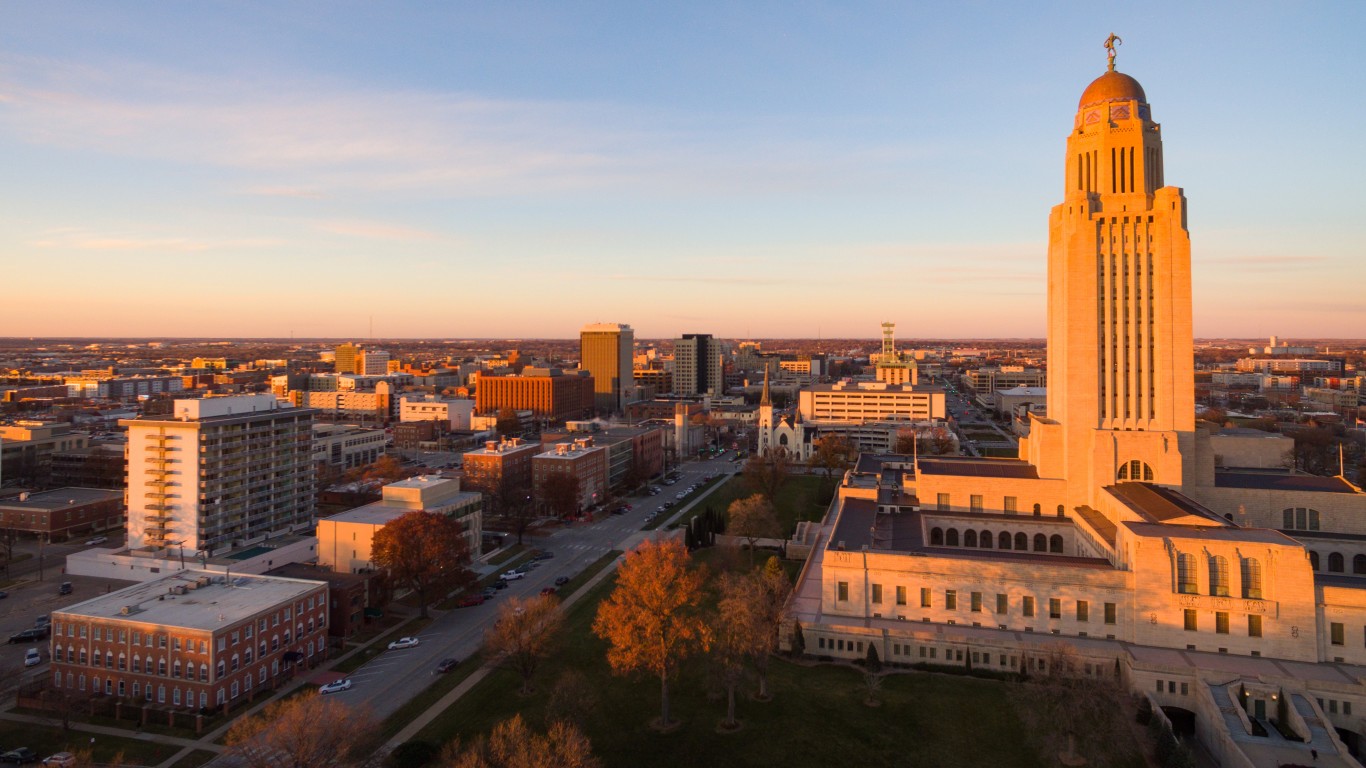
10. Nebraska
> 2018 unemployment: 2.8% (6th lowest)
> Pension funded ratio: 90.2% (8th highest)
> 1 yr. GDP growth: 0.9% (5th lowest)
> Poverty rate: 11.0% (14th lowest)
> Moody’s credit rating and outlook: Aa1/Stable
Many states take on large amounts of debt to fulfill budget obligations, but Nebraska is not one of them. The state’s outstanding debt is equal to only about $1,051 per resident, the second lowest debt per capita among states and less than a third of the $3,554 national average. The state also has funding for over 90% of its pension obligations, while most states have funding for less than 75% of their pension liabilities.
Nebraskans benefit from a particularly strong job market. Just 2.8% of workers in the state were out of a job on average in 2018, one of the smallest shares among states and well below the 3.9% national unemployment rate for 2018.

11. Massachusetts
> 2018 unemployment: 3.3% (14th lowest)
> Pension funded ratio: 59.9% (10th lowest)
> 1 yr. GDP growth: 3.1% (13th highest)
> Poverty rate: 10.0% (8th lowest)
> Moody’s credit rating and outlook: Aa1/Stable
Massachusetts ranks as the best-run state in the Northeast and the 11th best run nationwide. With an uninsured rate of just 2.8%, Massachusetts has done a better job of ensuring its residents have access to health care than every other state in the country. For context, 8.9% of Americans nationwide lack health insurance. Massachusetts also has a relatively strong job market, with an annual unemployment rate of just 3.3%, compared to a 3.9% national rate.
The low jobless rate is likely tied to rapid economic growth. Between 2017 and 2018, Massachusetts’s economy grew by 3.1%, faster than most states.
[in-text-ad]

12. Georgia
> 2018 unemployment: 3.9% (25th highest)
> Pension funded ratio: 79.2% (16th highest)
> 1 yr. GDP growth: 2.4% (24th lowest)
> Poverty rate: 14.3% (12th highest)
> Moody’s credit rating and outlook: Aaa/Stable
Georgia ranks as the second best-run state in the South, trailing only Texas, and the 12th best nationwide. People are moving to Georgia faster than most other states, and growing demand for housing has driven up property values. In the last year alone, the typical home in the state appreciated by 9.3%. Over the same period, the median home value nationwide climbed by just 5.6%.
Many states take on large amounts of debt to fulfill budget obligations, but Georgia does not. The state’s outstanding debt is equal to only about $1,253 per resident, the fourth lowest debt per capita among states and well below the $3,554 national average. Georgia is also one of only 15 states with a perfect triple A credit rating from Moody’s with a stable outlook from Moody’s.
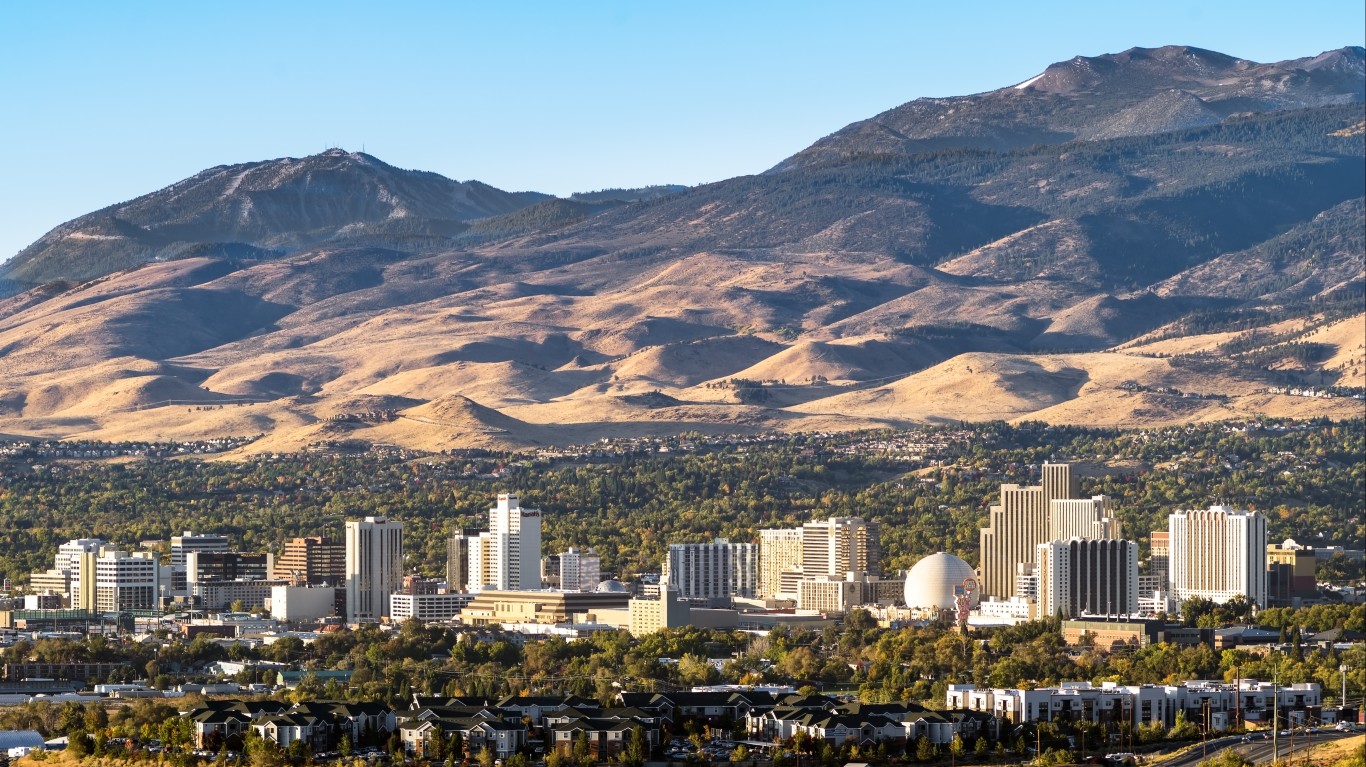
13. Nevada
> 2018 unemployment: 4.6% (8th highest)
> Pension funded ratio: 74.4% (24th highest)
> 1 yr. GDP growth: 4.2% (3rd highest)
> Poverty rate: 12.9% (24th highest)
> Moody’s credit rating and outlook: Aa1/Stable
Nevada has one of the fastest growing populations in the country. Due largely to an influx of new residents from out of state, Nevada’s population grew by 2.1% in the last year, more than triple the 0.6% national population growth over the same period. The population growth is likely helping fuel economic expansion, as Nevada’s 4.2% GDP growth in 2018 was nearly the highest among states and well above the comparable 2.9% national GDP growth.
Nevada does not rely as much on credit to fund its obligations. The state’s outstanding debt is equal to only about $1,093 per resident, the third lowest debt per capita among states and well below the $3,554 national average.

14. California
> 2018 unemployment: 4.2% (14th highest)
> Pension funded ratio: 68.9% (24th lowest)
> 1 yr. GDP growth: 4.3% (2nd highest)
> Poverty rate: 12.8% (25th highest)
> Moody’s credit rating and outlook: Aa2/Stable
California has the equivalent of 17.5% of its annual expenditures saved in a rainy day fund, a larger share than all but three other states and more than double the 8.3% average across all states. California also has one of the fastest growing economies in the United States. Between 2017 and 2018, California’s GDP grew by 4.3%, the second largest economic expansion among states, trailing only Washington state. Over the same period, the U.S. economy grew by 2.9%.
Despite the rapid GDP growth, California’s 4.2% jobless rate is slightly higher than the 3.9% national average. Still, by some measures, California is able to aid more of its unemployed residents. Of the more than 741,000 unemployed state residents, 45.6% receive UI benefits, well above the 27.4% national average.
[in-text-ad-2]

15. Tennessee
> 2018 unemployment: 3.5% (21st lowest)
> Pension funded ratio: 96.5% (3rd highest)
> 1 yr. GDP growth: 3.1% (12th highest)
> Poverty rate: 15.3% (10th highest)
> Moody’s credit rating and outlook: Aaa/Stable
Over the last year, Tennessee’s economy expanded by 3.1%, slightly faster than the comparable 2.9% national GDP growth. Economic growth can be closely tied to the health of the job market, and in Tennessee, just 3.5% of the labor force was unemployed in 2018, compared to the 3.9% share of workers nationwide.
Most states have funding for less than 75% of their pension obligations, and many are facing a pension crisis. Tennessee, meanwhile, has funding for 96.5% of its pension obligations, the third highest share among states, trailing only South Dakota and Wisconsin. Fiscally well managed, Tennessee is one of only 15 states with a perfect triple A rating and a stable outlook from Moody’s.

16. Wyoming
> 2018 unemployment: 4.1% (20th highest)
> Pension funded ratio: 75.9% (23rd highest)
> 1 yr. GDP growth: 0.1% (2nd lowest)
> Poverty rate: 11.1% (17th lowest)
> Moody’s credit rating and outlook: N/A
Wyoming is the only state in the country that has the equivalent of over 100% of its annual budget saved in a rainy day fund. Alaska has the next largest rainy day fund ratio in the country, at 56.4% of annual budget saved. Wyoming ‘s large rainy day fund positions it well to cope with a revenue shortfall or emergency spending.
In other areas, Wyoming is struggling more than most states. The state reported virtually no economic growth in the last year, and its 4.1% jobless rate is slightly higher than the 3.9% national average. Wyoming is one of only nine states to report population decline between 2017 and 2018, and in the last year, over 3,000 more people left Wyoming than moved there.
[in-text-ad]

17. Florida
> 2018 unemployment: 3.6% (22nd lowest)
> Pension funded ratio: 79.3% (15th highest)
> 1 yr. GDP growth: 3.2% (11th highest)
> Poverty rate: 13.6% (18th highest)
> Moody’s credit rating and outlook: Aaa/Stable
Largely due to net migration, Florida’s population is one of the fastest growing in the country. In the last year, Florida’s population grew by 1.5%, more than double the 0.6% national population growth. Population growth can fuel economic expansion, and Florida’s GDP grew by 3.2% in the last year, more than most states and the 2.9% national economic growth. Economic growth can also be closely tied to the strength of the job market, and Florida’s 3.6% 2018 unemployment rate is below the comparable 3.9% national figure.
By some measures, however, Florida is below average. For example, the state’s 13.6% poverty rate is slightly higher than the 13.1% national rate. Similarly, Florida’s violent crime rate of 385 incidents per 100,000 people is slightly higher than 369 per 100,000 national rate.
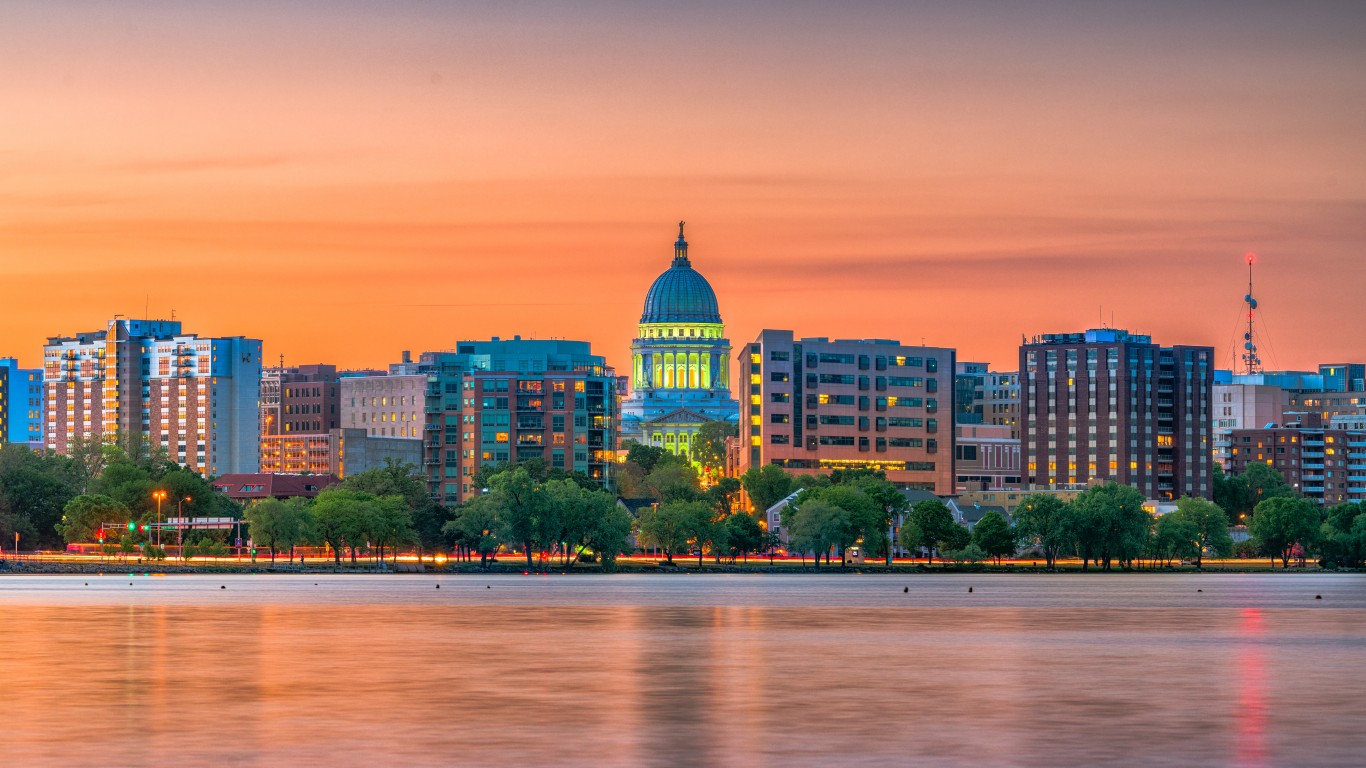
18. Wisconsin
> 2018 unemployment: 3.0% (9th lowest)
> Pension funded ratio: 102.6% (the highest)
> 1 yr. GDP growth: 2.4% (22nd lowest)
> Poverty rate: 11.0% (14th lowest)
> Moody’s credit rating and outlook: Aa1/Stable
Though Wisconsin is one of 14 states that chose not to expand Medicaid under the Affordable Care Act, state residents are more likely to have health insurance than the typical American. The uninsured rate in Wisconsin is 5.5%, well below the 8.9% national rate. Wisconsin residents are also less likely to live in poverty and more likely to own their home than the typical American. Such strong socioeconomic indicators are partially attributable to the state’s healthy job market. Just 3.0% of the workforce in the state was unemployed in 2018, well below the 3.9% national unemployment rate.
Wisconsin relies heavily on credit to fund operations. The state’s debt is equal to 49.7% of its annual budget, more than most states. Additionally, Wisconsin has the equivalent of only 1.9% of its annual expenditures in a rainy day fund, well below the 8.3% average across all states.

19. Vermont
> 2018 unemployment: 2.7% (5th lowest)
> Pension funded ratio: 64.3% (17th lowest)
> 1 yr. GDP growth: 1.2% (6th lowest)
> Poverty rate: 11.0% (14th lowest)
> Moody’s credit rating and outlook: Aa1/Stable
Vermont is the second best-run state in the Northeast and the 19th best run nationwide. Vermont allocates a larger than typical share of its budget to education, and the state’s school system appears to be effective by some measures. Of all adults 25 and older in the state, 93.5% have a high school diploma, the second highest share among states, trailing only Montana. Vermonters are also more likely than Americans on average to be college educated — 38.7% of adults in the state have at least a bachelor’s degree, compared to 32.6% of adults nationwide. Better-educated adults are less likely to be out of a job, and Vermont’s 2.7% unemployment rate is well below the 3.9% national rate.
Economic growth in Vermont has been sluggish recently. In 2018, Vermont’s economy expanded by just 1.2%. Over the same period, the national GDP increased by 2.9%.
[in-text-ad-2]

20. Virginia
> 2018 unemployment: 3.0% (9th lowest)
> Pension funded ratio: 77.2% (20th highest)
> 1 yr. GDP growth: 2.6% (18th highest)
> Poverty rate: 10.7% (11th lowest)
> Moody’s credit rating and outlook: Aaa/Stable
Virginia is a relatively safe state. There were just 200 violent crimes reported for every 100,000 people in the state in 2018, well below the national violent crime rate of 369 per 100,000. Crime rates tend to be lower in places with better economic conditions, and Virginia has one of the strongest job markets of any state. Just 3.0% of the Virginia workforce was out of a job in 2018, well below the 3.9% national unemployment rate.
Virginia may not be as well equipped as most states to weather an economic downturn or provide emergency funding. Though the state makes regular deposits into a rainy day fund, it currently has the equivalent of just 2.2% of its annual expenditures saved in such a fund, well below the 8.3% national average.
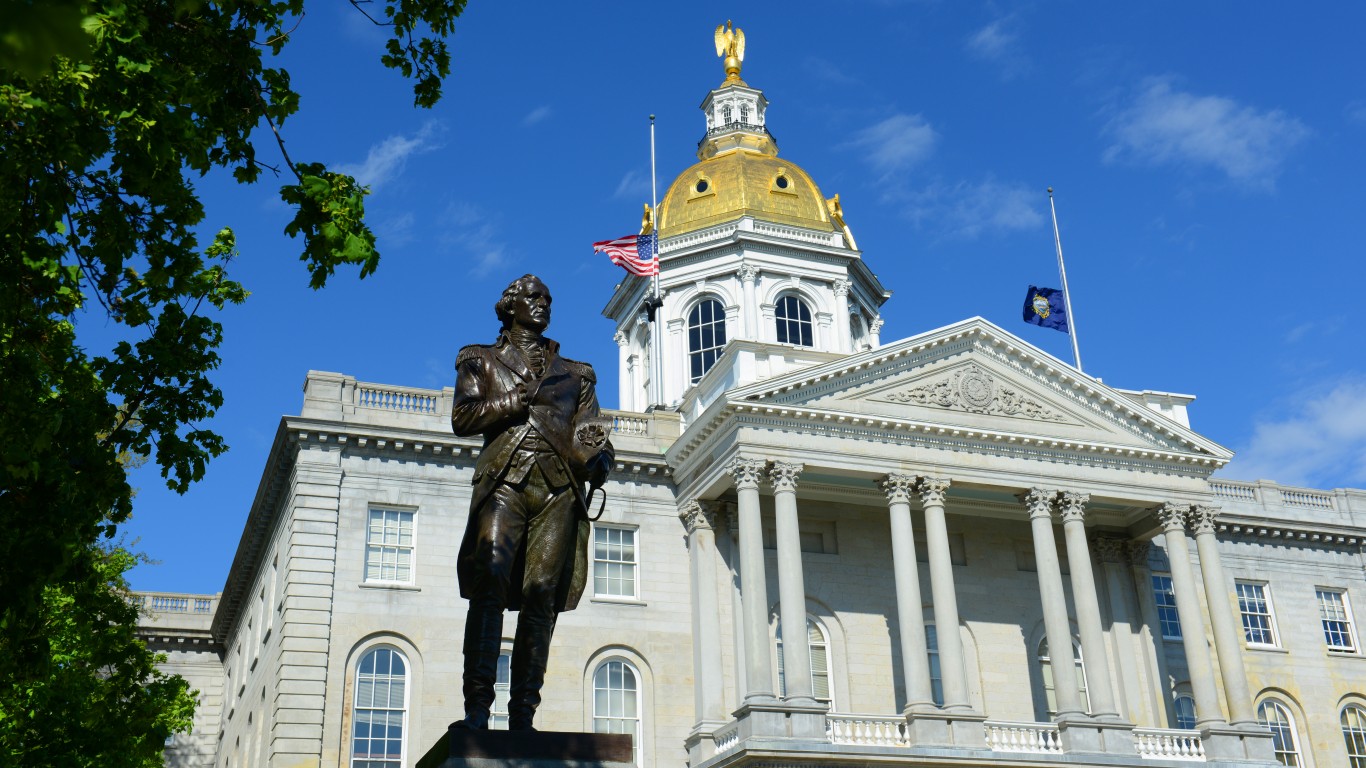
21. New Hampshire
> 2018 unemployment: 2.5% (2nd lowest)
> Pension funded ratio: 62.7% (14th lowest)
> 1 yr. GDP growth: 2.3% (21st lowest)
> Poverty rate: 7.6% (the lowest)
> Moody’s credit rating and outlook: Aa1/Stable
People living in New Hampshire are far less likely to face serious financial hardship than the typical American. The poverty rate in New Hampshire is just 7.6%, the lowest of any state and well below the 13.1% national rate. The lower incidence of poverty is partially the product of a strong job market. Just 2.5% of workers in New Hampshire were out of a job in 2018, a far smaller share than the 3.9% national unemployment rate.
New Hampshire relies heavily on credit to fund state operations, however. The state has an outstanding debt equivalent to $5,734 per resident, one of the highest debts per capita of any state.
[in-text-ad]

22. North Carolina
> 2018 unemployment: 3.9% (25th highest)
> Pension funded ratio: 90.7% (6th highest)
> 1 yr. GDP growth: 2.4% (25th highest)
> Poverty rate: 14.0% (15th highest)
> Moody’s credit rating and outlook: Aaa/Stable
North Carolina is one of the 15 states with a perfect triple A credit rating and a stable outlook from Moody’s. Indeed, the state has funding for over 90% of its pension obligations — far more than most states. The state also has relatively little overall debt.
Economic growth, however, has been modest in North Carolina lately. The state’s economy grew by just 2.4% in 2018, below the 2.9% national GDP growth last year. Stronger economic growth could help reduce poverty in the state. North Carolina’s poverty rate of 14.0% is slightly higher than the 13.1% national rate.

23. Delaware
> 2018 unemployment: 3.8% (25th lowest)
> Pension funded ratio: 82.8% (11th highest)
> 1 yr. GDP growth: 0.0% (the lowest)
> Poverty rate: 12.5% (24th lowest)
> Moody’s credit rating and outlook: Aaa/Stable
Delaware was the only state to report no economic growth in 2018. Economic stagnation in the state stood in stark contrast to the national 2.9% GDP growth over the same period. Still, by other measures, Delaware’s economy is performing as well or better than the national economy as a whole. For example, the state’s 3.8% unemployment rate is slightly lower than the 3.9% national rate. Additionally, just 12.5% of state residents live below the poverty line compared to 13.1% of Americans nationwide. Delaware also has funding for 82.8% of its pension obligations, while most states have less than 75% of pension obligations funded.

24. Michigan
> 2018 unemployment: 4.1% (20th highest)
> Pension funded ratio: 65.1% (20th lowest)
> 1 yr. GDP growth: 2.5% (22nd highest)
> Poverty rate: 14.1% (13th highest)
> Moody’s credit rating and outlook: Aa1/Stable
Financial insecurity is more common in Michigan than it is nationwide on average. Across the state, 14.1% of the population lives below the poverty line, compared to the national poverty rate of 13.1%. The higher poverty rate in the state may be partially attributable to a weaker than average job market. Michigan’s annual unemployment rate of 4.1% is slightly higher than the comparable 3.9% national rate.
Michigan is better prepared than most states to weather economic downturns and have emergency funding. The state has the equivalent of 9.9% of its annual budget saved in a rainy day fund, above the 8.3% average across all states.
[in-text-ad-2]

25. Hawaii
> 2018 unemployment: 2.4% (the lowest)
> Pension funded ratio: 54.8% (8th lowest)
> 1 yr. GDP growth: 2.4% (23rd lowest)
> Poverty rate: 8.8% (2nd lowest)
> Moody’s credit rating and outlook: Aa1/Stable
Just 8.8% of Hawaiians live below the poverty line, well below the 13.1% of Americans nationwide. The greater likelihood of financial security is likely due in part to the state’s strong job market. Just 2.4% of workers in Hawaii were out of a job in 2018, the lowest unemployment rate among states and well below the 3.9% national rate.
Like many other states that rank lower on this list, Hawaii may be facing a pension crisis. Currently, the state has funding for just 54.8% of its pension obligations. Across all states, the average pension funded ratio is 69.1%.

26. Montana
> 2018 unemployment: 3.7% (23rd lowest)
> Pension funded ratio: 72.8% (25th highest)
> 1 yr. GDP growth: 2.6% (15th highest)
> Poverty rate: 13.0% (22nd highest)
> Moody’s credit rating and outlook: Aa1/Stable
The typical household in Montana has an income of $55,328 a year, less than the $61,937 national median household income. Still, Montana residents are not more likely to face serious financial hardship than the typical American. Just 13.0% of the state population lives below the poverty line, closely in line with the 13.1% national poverty rate.
Montana is not as well equipped as most states to fund government operations in the event of a revenue shortfall or emergency. Montana is one of only four states with no money set aside in a rainy day fund.
[in-text-ad]
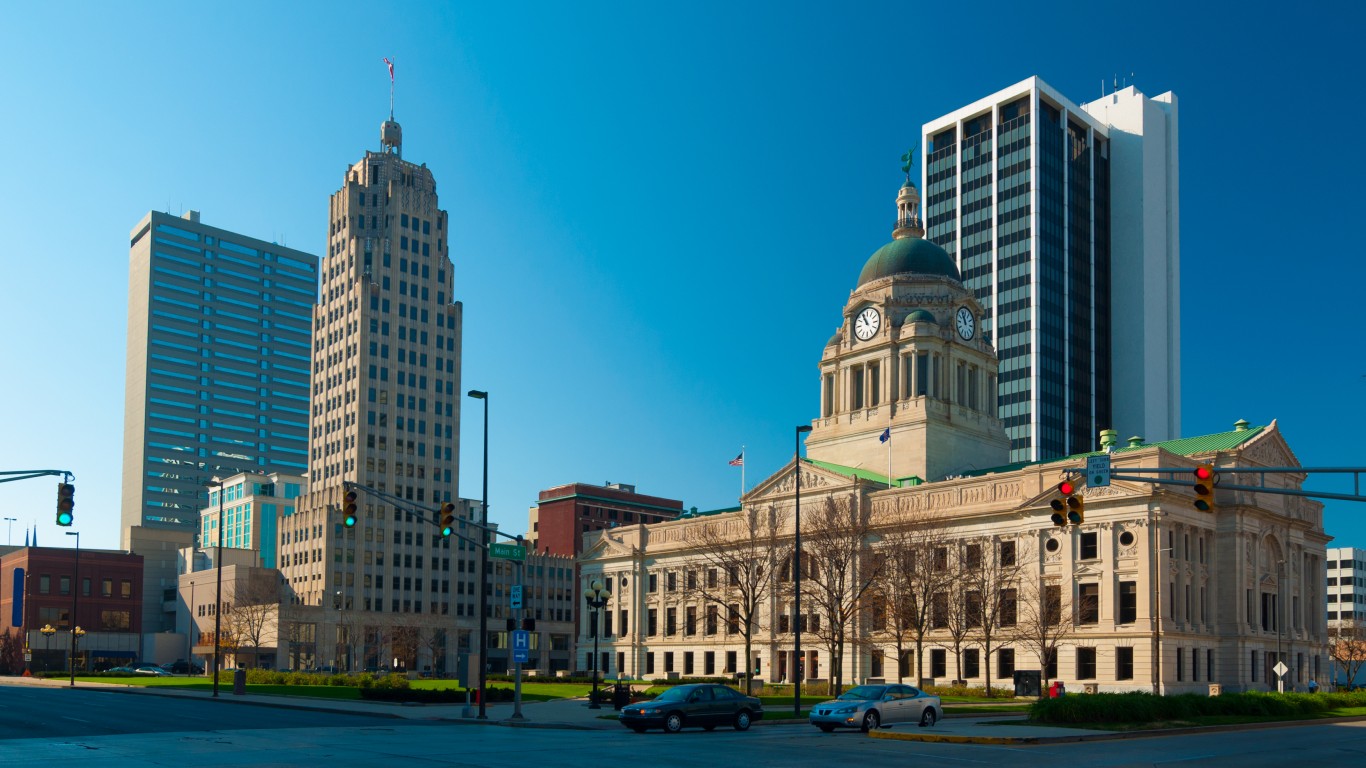
27. Indiana
> 2018 unemployment: 3.4% (16th lowest)
> Pension funded ratio: 65.0% (18th lowest)
> 1 yr. GDP growth: 2.0% (14th lowest)
> Poverty rate: 13.1% (21st highest)
> Moody’s credit rating and outlook: Aaa/Stable
Indiana is one of only 15 states with a perfect triple A credit rating and a stable outlook from Moody’s. Still, it is not without some budgetary problems. The state has funding for only about 65% of its pension obligations, one of the lowest funding ratios of any state.
In several socioeconomic measures, Indiana fares as well or better than the nation as a whole. For example, the state’s annual unemployment rate of 3.4% is below the national rate of 3.9%. Additionally, though the median household income of $55,746 in the state is about $6,000 below the national median, Indiana’s poverty rate of 13.1% is in line with the national rate.

28. Maryland
> 2018 unemployment: 3.9% (25th highest)
> Pension funded ratio: 68.6% (23rd lowest)
> 1 yr. GDP growth: 2.5% (24th highest)
> Poverty rate: 9.0% (3rd lowest)
> Moody’s credit rating and outlook: Aaa/Stable
The typical Maryland household earns $83,242 a year, about $21,300 more than the typical American household and the highest median household income of any state. Additionally, Maryland’s poverty rate of just 9.0% is among the lowest of any state and well below the 13.1% national poverty rate.
Though Maryland is one of 15 states with a perfect triple A credit rating and a stable outlook from Moody’s, the state is not in as sound fiscal shape as many others. For one, Maryland has funding for only 68.6% of its pension obligations, below the average across states. Additionally, with only 5.0% of its annual budget saved in a rainy day fund, Maryland is not as well equipped as most states to fund government operations in the event of a revenue shortfall or emergency.
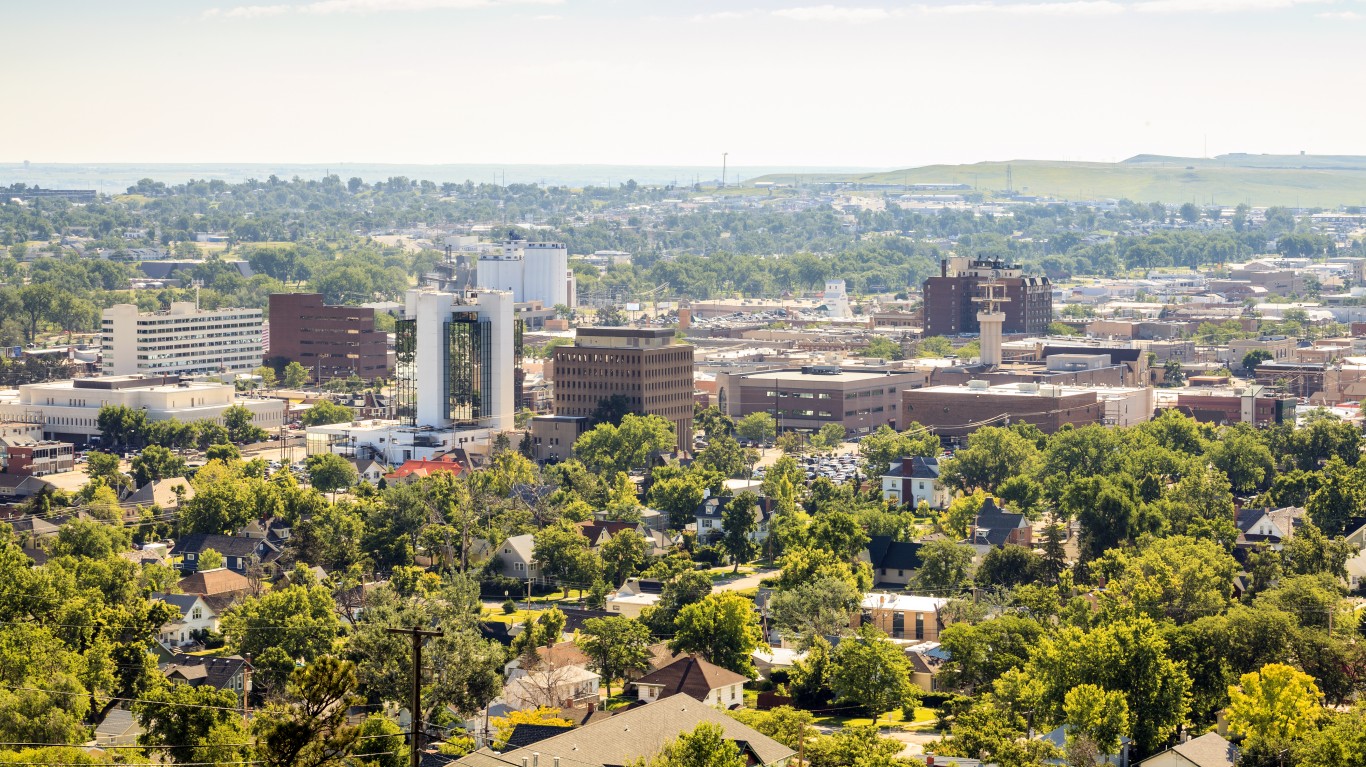
29. South Dakota
> 2018 unemployment: 3.0% (9th lowest)
> Pension funded ratio: 100.1% (2nd highest)
> 1 yr. GDP growth: 1.9% (13th lowest)
> Poverty rate: 13.1% (21st highest)
> Moody’s credit rating and outlook: Aaa/Stable
South Dakota is better managed fiscally than most states. The state has a perfect triple A credit rating from Moody’s and enough saved in a rainy day fund to allow the government to operate for an entire year without any revenue. South Dakota residents also benefit from a strong job market. Just 3.0% of the state’s labor force was out of work in 2018, well below the comparable 3.9% national unemployment rate.
Economic growth has been relatively stagnant in South Dakota recently. The state’s economy expanded by just 1.9% in 2018, slower than most states and well below the 2.9% national GDP growth last year.
[in-text-ad-2]

30. Maine
> 2018 unemployment: 3.4% (16th lowest)
> Pension funded ratio: 81.9% (13th highest)
> 1 yr. GDP growth: 2.2% (18th lowest)
> Poverty rate: 11.6% (19th lowest)
> Moody’s credit rating and outlook: Aa2/Stable
The typical household in Maine earns $55,602 a year, about $6,300 less than the typical American household. Despite the lower incomes, Maine residents are less likely to face serious financial hardship than most Americans. Just 11.6% of the Maine population lives below the poverty line, below the 13.1% national poverty rate. Maine is also a relatively safe place. There were only 112 violent crimes reported in the state for every 100,000 people in 2018, the lowest violent crime rate among states and well below the 369 per 100,000 national violent crime rate.
Economic growth has been relatively sluggish in Maine recently. The state’s economy expanded by just 2.2% in 2018, slower than most states and below the 2.9% national GDP growth last year.

31. Ohio
> 2018 unemployment: 4.6% (8th highest)
> Pension funded ratio: 80.1% (14th highest)
> 1 yr. GDP growth: 1.9% (12th lowest)
> Poverty rate: 13.9% (16th highest)
> Moody’s credit rating and outlook: Aa1/Stable
Economic conditions in Ohio are bleaker than in most other states. Ohio’s 4.6% 2018 unemployment rate is higher than in the majority of states and above the 3.9% national rate. The job market can be closely tied to overall economic growth, and GDP growth has been sluggish in Ohio. The state’s economy expanded by just 1.9% in 2018, far slower than the comparable 3.9% national growth.
Still, Ohio does as well or better than the U.S. as a whole in some other socioeconomic and other measures. A relatively safe state, Ohio’s violent crime rate of 280 incidents per 100,000 people is lower than the 369 per 100,000 national rate. Additionally, while many states are facing a pension crisis, Ohio has funding for over 80% of its pension obligations, far higher than the 69.1% average funded ratio across all states.
[in-text-ad]
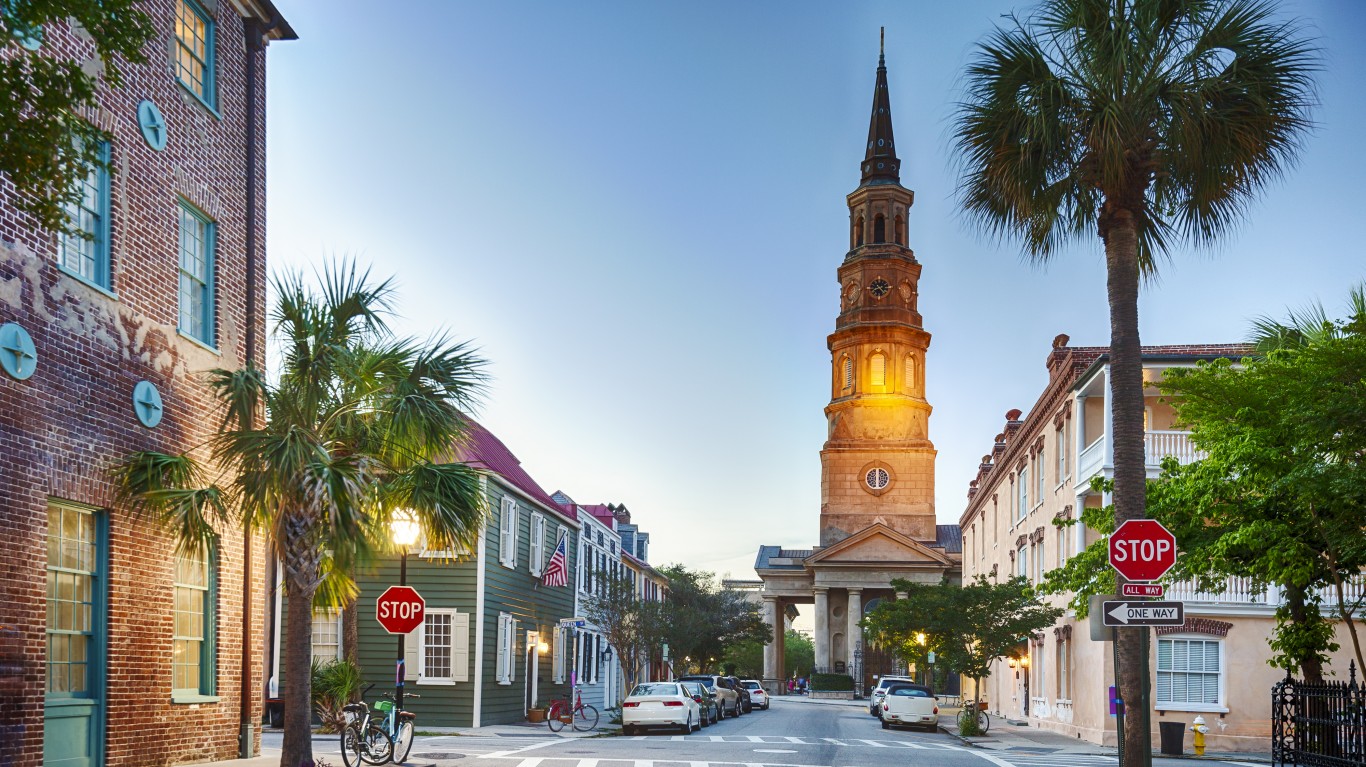
32. South Carolina
> 2018 unemployment: 3.4% (16th lowest)
> Pension funded ratio: 54.3% (7th lowest)
> 1 yr. GDP growth: 2.6% (17th highest)
> Poverty rate: 15.3% (10th highest)
> Moody’s credit rating and outlook: Aaa/Stable
South Carolina is one of only 15 states with a perfect triple A credit rating and a stable outlook from Moody’s. Still, it is not without some budgetary problems. South Carolina has funding for only about 54% of its pension obligations, one of the lowest funding ratios of any state.
State residents benefit from a strong job market. Just 3.4% of workers were out of a job, on average, in 2018, a smaller share than the 3.9% nationwide annual unemployment rate. Despite the availability of jobs, a relatively large share of the state population is struggling financially. Some 15.3% of South Carolinians live below the poverty line, the 10th highest poverty rate among states.
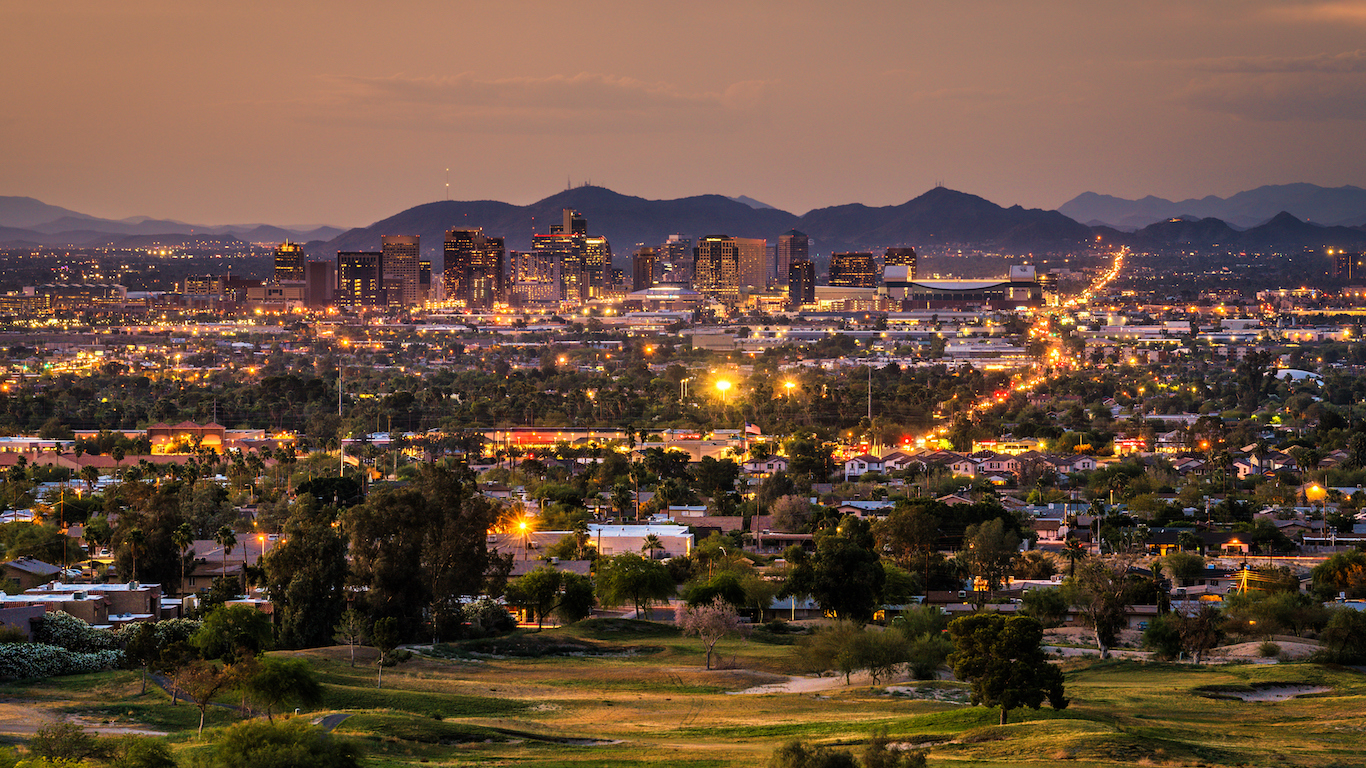
33. Arizona
> 2018 unemployment: 4.8% (6th highest)
> Pension funded ratio: 62.2% (12th lowest)
> 1 yr. GDP growth: 4.1% (4th highest)
> Poverty rate: 14.0% (15th highest)
> Moody’s credit rating and outlook: Aa2/Stable
Arizona’s population is growing far faster than most states. From July 2017 to July 2018, largely due to inbound migration, the state population grew by 1.7%, the fourth fastest population growth rate among states. Population growth can contribute to economic growth, and Arizona’s economy expanded by 4.1% last year, the fourth highest growth rate among states and well above the national 2.9% GDP growth.
Despite the rapid economic growth, Arizona’s job market is one of the weakest in the country. Arizona’s annual unemployment rate of 4.8% is higher than in all but five other states and is well above the 3.9% national average.
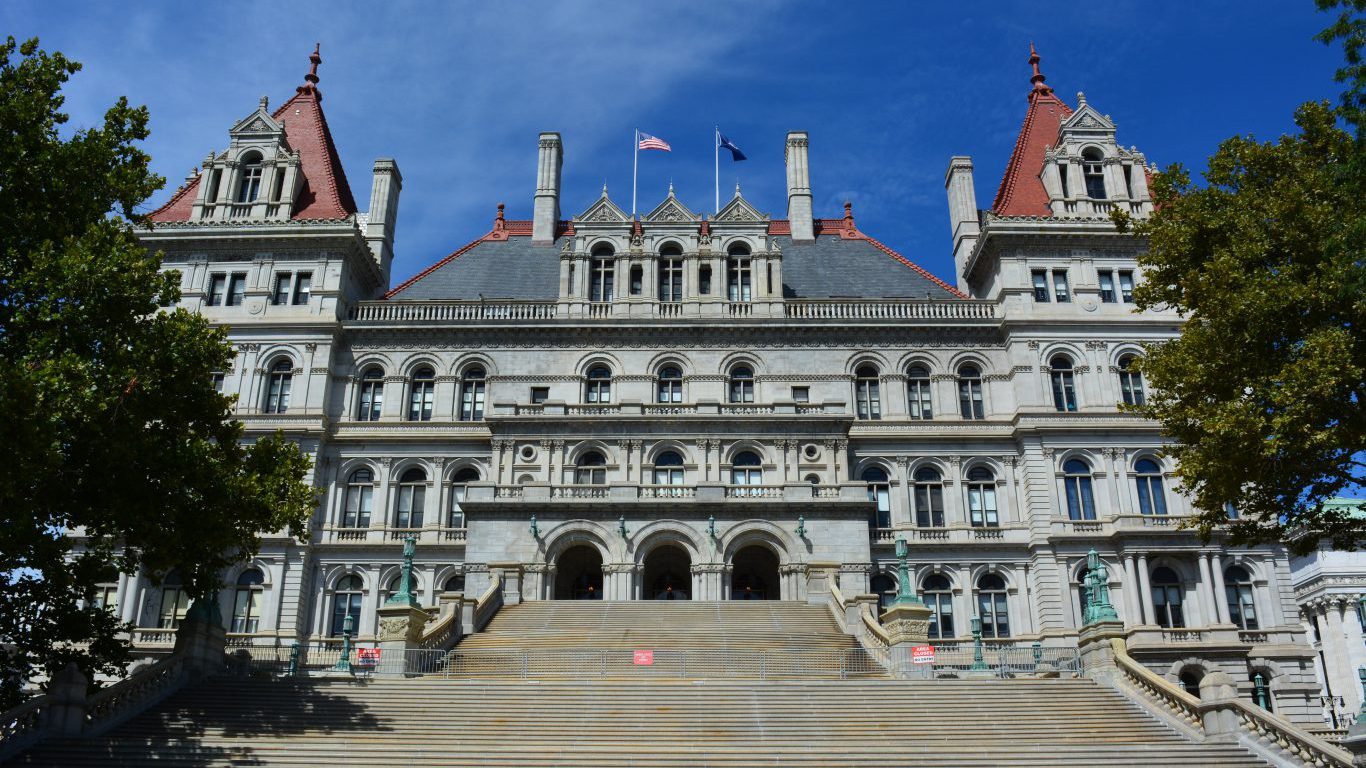
34. New York
> 2018 unemployment: 4.1% (20th highest)
> Pension funded ratio: 94.5% (4th highest)
> 1 yr. GDP growth: 1.2% (7th lowest)
> Poverty rate: 13.6% (18th highest)
> Moody’s credit rating and outlook: Aa1/Stable
By several measures, New York’s economy is lagging behind much of the rest of the country. For one, the state’s 1.2% economic growth in 2018 was slower than all but six other states and well below the 2.9% national growth. Joblessness is also a problem in New York, as the state’s 4.1% unemployment rate is higher than most states and the 3.9% national rate.
New York is not lagging behind the rest of the country in all measures, however. While many states are facing a pension crisis, New York has funding for about 95% of its pension obligations, far higher than the 69.1% average funded ratio across all states.
[in-text-ad-2]
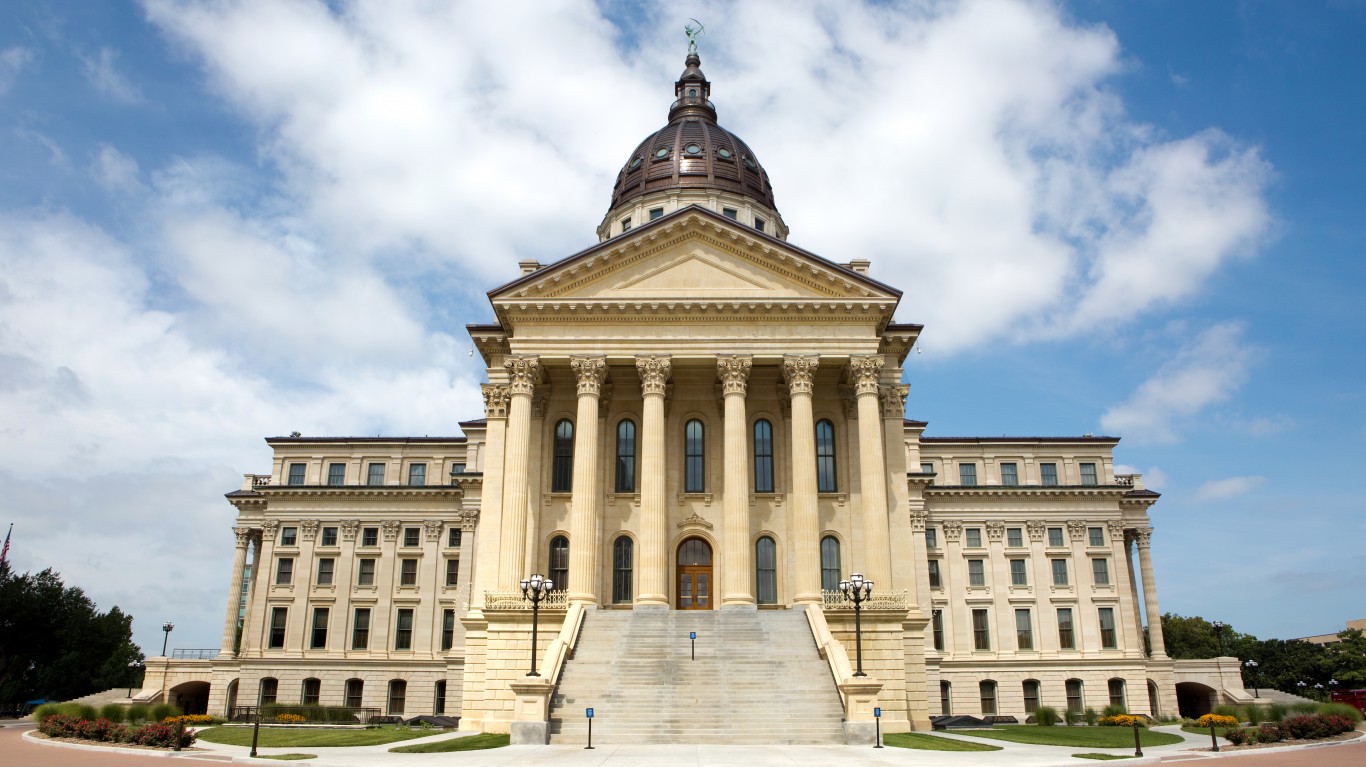
35. Kansas
> 2018 unemployment: 3.4% (16th lowest)
> Pension funded ratio: 67.1% (22nd lowest)
> 1 yr. GDP growth: 2.1% (15th lowest)
> Poverty rate: 12.0% (21st lowest)
> Moody’s credit rating and outlook: Aa2/Stable
More people left Kansas between mid-2017 and mid-2018 than moved into the state over that period. Population decline or stagnation can be a drag on economic output, and last year, the Kansas economy grew by only 2.1%, slower than the 2.9% national economic growth.
Kansas is not as prepared as most states to fund government services in the event of a revenue shortfall. It is one of only four states nationwide with nothing saved in a rainy day fund. Kansas also only has funding for only 67.1% of its total pension obligations.

36. Connecticut
> 2018 unemployment: 4.1% (20th highest)
> Pension funded ratio: 45.7% (4th lowest)
> 1 yr. GDP growth: 0.5% (3rd lowest)
> Poverty rate: 10.4% (10th lowest)
> Moody’s credit rating and outlook: A1/Stable
Connecticut has one of the slowest-growing economies in the United States. The state’s economy expanded by just 0.5% in 2018. Over the same period, the U.S. economy grew by 2.9%. Connecticut also has one of the most underfunded pension systems in the country. The state has funding for just 45.7% of its total pension obligations. The state is also not as prepared as most states to fund operations in the event of an economic downturn. The state has the equivalent of just 6.3% of its annual expenditures saved in a rainy day fund, below the 8.3% average savings across all states.
[in-text-ad]

37. Alabama
> 2018 unemployment: 3.9% (25th highest)
> Pension funded ratio: 70.9% (25th lowest)
> 1 yr. GDP growth: 2.8% (14th highest)
> Poverty rate: 16.8% (7th highest)
> Moody’s credit rating and outlook: Aa1/Stable
Alabama is one of the poorest states in the country. The typical household in the state earns just $49,861 a year, about $12,000 less than the typical American household. Additionally, 16.8% of Alabama residents live below the poverty line, well above the 13.1% national poverty rate. Alabama is also a relatively dangerous state. There were 520 violent crimes for every 100,000 people in the state in 2018, considerably higher than the 369 per 100,000 national violent crime rate.
Economic growth in Alabama is on pace with that of the nation as a whole. The state’s economy grew by 2.8% in 2018, in line with the 2.9% national GDP growth over the same period.

38. Pennsylvania
> 2018 unemployment: 4.3% (12th highest)
> Pension funded ratio: 55.3% (9th lowest)
> 1 yr. GDP growth: 2.6% (19th highest)
> Poverty rate: 12.2% (23rd lowest)
> Moody’s credit rating and outlook: Aa3/Stable
Pennsylvania has one of the weaker job markets among states. In 2018, an average of 4.3% of workers in the state were unemployed, a far larger share than the 3.9% national unemployment rate. Pennsylvania is also less equipped than most states to fund government operations in the event of a revenue shortfall. The state is one of only four nationwide with no money set aside in a rainy day fund. Pennsylvania may also be facing a pension crisis — it has enough funding to cover only 55.3% of its total pension obligations.

39. Missouri
> 2018 unemployment: 3.2% (13th lowest)
> Pension funded ratio: 77.9% (18th highest)
> 1 yr. GDP growth: 2.4% (25th lowest)
> Poverty rate: 13.2% (19th highest)
> Moody’s credit rating and outlook: Aaa/Stable
Missouri has a relatively weak economy. The state’s GDP per capita of $46,507 is over $10,000 below the GDP per capita nationwide. Not surprisingly, incomes are also relatively low in the state. The typical Missouri household earns $54,478 a year, well below the $61,937 median household income nationwide.
Economic growth has also been sluggish in Missouri recently. The state’s economy expanded by 2.4% in 2018, slower than the 2.9% national GDP growth last year. Missouri is also less equipped than most states to fund operations in the event of a budget shortfall. The state has the equivalent of just 3.3% of its annual expenditures saved in a rainy day fund, far less than the majority of states.
[in-text-ad-2]

40. Arkansas
> 2018 unemployment: 3.7% (23rd lowest)
> Pension funded ratio: 76.9% (21st highest)
> 1 yr. GDP growth: 1.7% (11th lowest)
> Poverty rate: 17.2% (5th highest)
> Moody’s credit rating and outlook: Aa1/Stable
With a GDP per capita of just $38,919 — well below the $56,968 comparable national figure — Arkansas has one of the weakest economies in the country. The state’s poverty rate of 17.2% is far higher than the 13.1% national rate. The Arkansas economy is also growing slower than average. The state’s GDP increased by just 1.7% in 2018, well below the 2.9% national 2018 economic growth.
Crime tends to be more concentrated in areas with higher poverty, and Arkansas is a relatively dangerous state. There were 544 violent crimes for every 100,000 people in the state in 2018, one of the highest violent crime rates among states and far higher than the 369 per 100,000 national violent crime rate.

41. New Jersey
> 2018 unemployment: 4.1% (20th highest)
> Pension funded ratio: 35.8% (2nd lowest)
> 1 yr. GDP growth: 2.2% (19th lowest)
> Poverty rate: 9.5% (5th lowest)
> Moody’s credit rating and outlook: A3/Stable
Few state governments are saddled with as much debt as New Jersey. The state has an outstanding balance of nearly $66 billion — equal to $7,411 per resident, one of the highest debt per capita figures of any state. The state also has a woefully underfunded pension system, with funding for only 35.8% of its total pension obligations. The state government’s financial woes do not stop there. New Jersey is one of only four states with no savings set aside to fund government operations in the event of a revenue shortfall.
People living in the state are also less likely to be able to find a job than most Americans. New Jersey’s annual unemployment rate of 4.1% is higher than the comparable 3.9% national rate.
[in-text-ad]

42. Rhode Island
> 2018 unemployment: 4.1% (20th highest)
> Pension funded ratio: 53.7% (6th lowest)
> 1 yr. GDP growth: 1.2% (8th lowest)
> Poverty rate: 12.9% (24th highest)
> Moody’s credit rating and outlook: Aa2/Stable
Rhode Island is the lowest ranking state in the Northeast on this list. The state’s economy grew by just 1.2% in 2018, less than half the comparable 2.9% national GDP growth the same year. A more rapid economic growth could improve the state’s job market. Currently, Rhode Island’s annual unemployment rate of 4.1% is higher than in most states and the 3.9% national rate.
Rhode Island may be facing a pension crisis. The state has funding for just 53.7% of its pension obligations, less than all but five other states.

43. Kentucky
> 2018 unemployment: 4.3% (12th highest)
> Pension funded ratio: 33.9% (the lowest)
> 1 yr. GDP growth: 1.4% (10th lowest)
> Poverty rate: 16.9% (6th highest)
> Moody’s credit rating and outlook: Aa3/Stable
Kentucky has the most underfunded pension system in the United States. The state has enough money to fund only 33.9% of its total pension obligations. It is also not well equipped to to fund government operations in the event of a revenue shortfall, with the equivalent of only 0.8% of its annual expenditures saved in a rainy day fund. The average rainy day fund savings across all states is equal to 8.3% of annual expenditures. Economic growth has also been sluggish in Kentucky lately. The state’s economy grew by just 1.4% in 2018, less than half the comparable 2.9% national GDP growth rate.
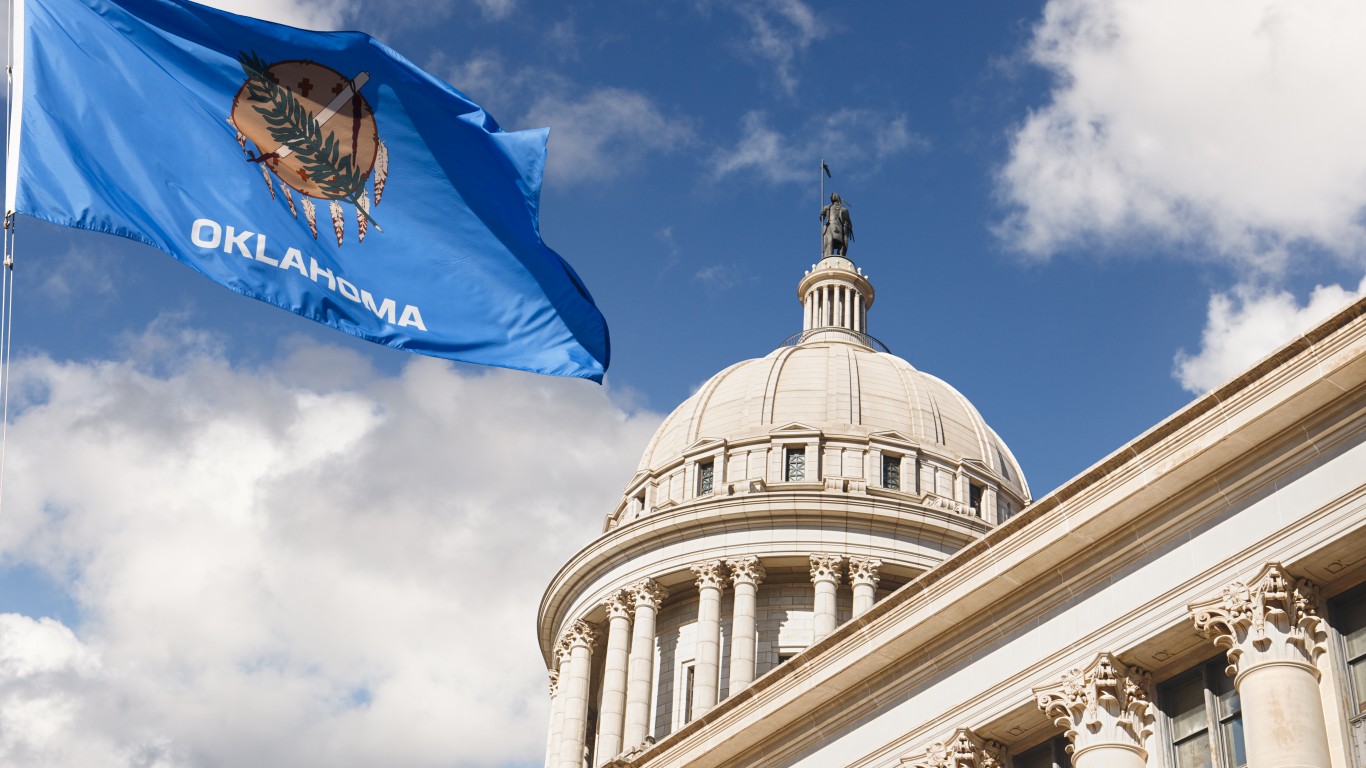
44. Oklahoma
> 2018 unemployment: 3.4% (16th lowest)
> Pension funded ratio: 77.9% (18th highest)
> 1 yr. GDP growth: 2.6% (20th highest)
> Poverty rate: 15.6% (8th highest)
> Moody’s credit rating and outlook: Aa2/Positive
Oklahoma is one of only 14 states that chose not to expand Medicaid coverage under the Affordable Care Act. Given the relatively high poverty rate in the state, a large share of residents could have likely benefited from the Medicaid expansion. Some 15.6% of Oklahoma residents live below the poverty line, a larger share than the 13.1% national poverty rate. Currently, 14.2% of people living in Oklahoma are uninsured, the second highest uninsured rate after only Texas and well above the 8.9% national uninsured rate.
Crime tends to be more concentrated in more impoverished areas, and Oklahoma is a relatively dangerous state. There were 466 violent crimes for every 100,000 people in the state in 2018, one of the higher violent crime rates among states and far higher than the 369 per 100,000 national violent crime rate.
[in-text-ad-2]
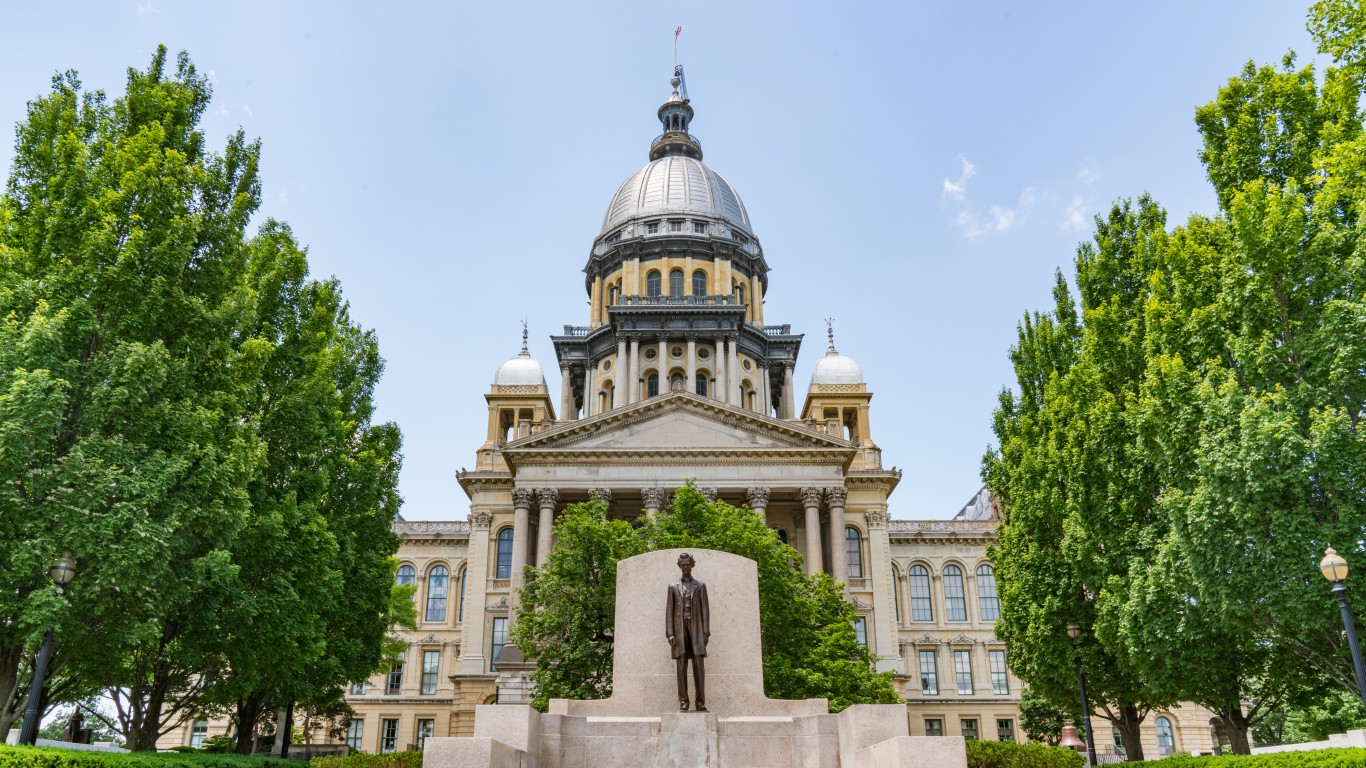
45. Illinois
> 2018 unemployment: 4.3% (12th highest)
> Pension funded ratio: 38.4% (3rd lowest)
> 1 yr. GDP growth: 2.1% (16th lowest)
> Poverty rate: 12.1% (22nd lowest)
> Moody’s credit rating and outlook: Baa3/Stable
Illinois is the only Midwestern state to rank among the bottom 10 states on this list. It is facing a worse pension crisis than nearly every other state, with enough money to fund only 38.4% of its total pension obligations. The state may also struggle to fund basic state operations in the event of a budget shortfall as it is one of only four states with no money put away in a rainy day fund.
Illinois is also a relatively dangerous states, with 404 violent crimes for every 100,000 people in 2018, well above the 369 per 100,000 national violent crime rate. Crime tends to be more common in areas with weaker economies, and in Illinois, the unemployment rate is 4.3%, 12th highest among states and well above the 3.9% national rate.
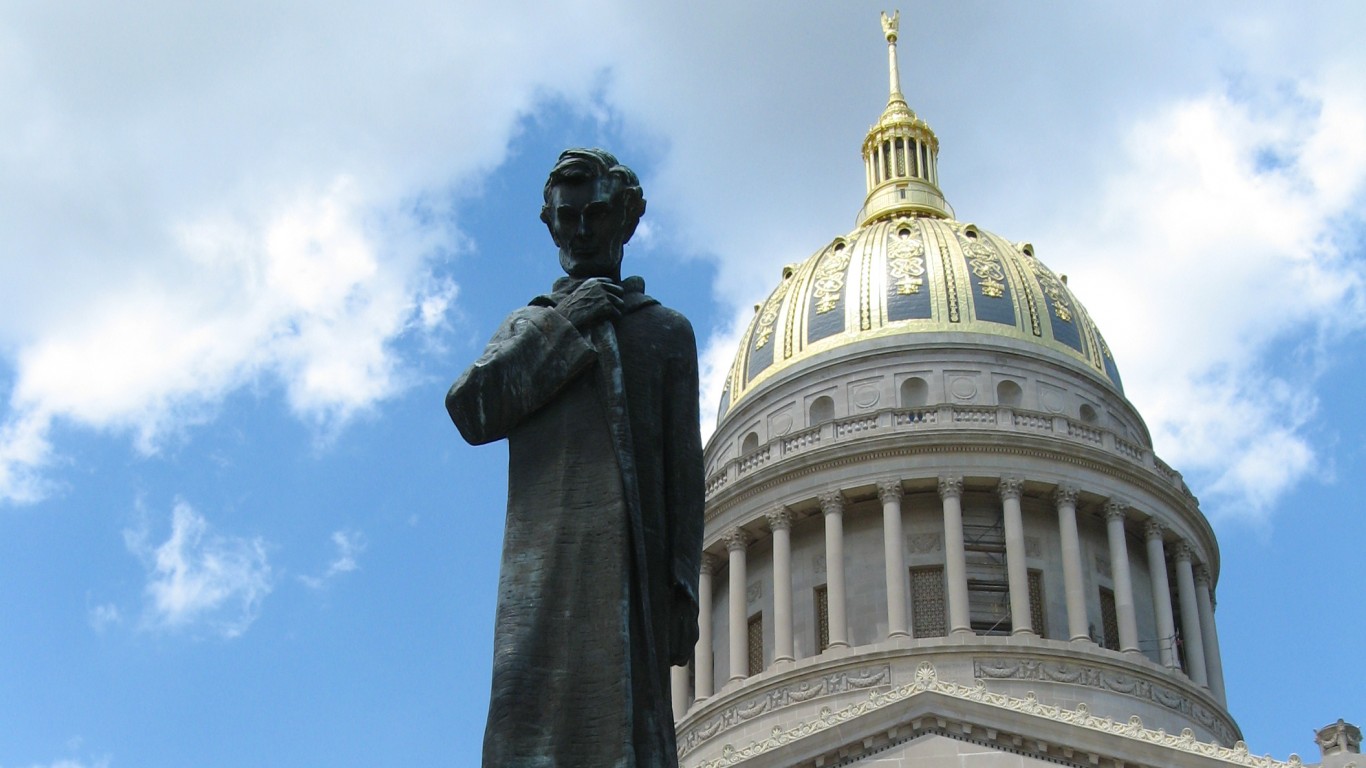
46. West Virginia
> 2018 unemployment: 5.3% (2nd highest)
> Pension funded ratio: 78.9% (17th highest)
> 1 yr. GDP growth: 2.3% (20th lowest)
> Poverty rate: 17.8% (4th highest)
> Moody’s credit rating and outlook: Aa2/Stable
Joblessness is a bigger problem in West Virginia than anywhere else in the lower 48. The state’s annual unemployment rate of 5.3% is well above the comparable 3.9% national rate. Likely in part due to the weak job market, many in the state are struggling financially. Some 17.8% of West Virginians live below the poverty line, a larger share than in all but three other states and far higher than the 13.1% national poverty rate.
Poor economic conditions may also explain why West Virginia reported the largest population decline of any state between mid-2017 and mid-2018. Over that period, largely due to people moving out, West Virginia’s population shrank by 0.6%, even as the total U.S. population grew by 0.6%.
[in-text-ad]

47. Alaska
> 2018 unemployment: 6.6% (the highest)
> Pension funded ratio: 66.6% (21st lowest)
> 1 yr. GDP growth: 0.7% (4th lowest)
> Poverty rate: 10.9% (13th lowest)
> Moody’s credit rating and outlook: Aa3/Negative
Joblessness is more of a problem in Alaska than in any other state. The state’s annual unemployment rate is 6.6%, far higher than the 3.9% national rate in 2018. The strength of a job market can be closely tied to GDP growth, and Alaska has one of the slowest growing economies in the country. Alaska’s economy grew by 0.7% in 2018, a fraction of the 2.9% national GDP growth in 2018.
Crime tends to be more concentrated in areas with high unemployment, and not only does Alaska have the nation’s highest jobless rate, but it also has the highest violent crime rate. There were 885 violent crimes for every 100,000 people in the state in 2018, more than double 369 per 100,000 national violent crime rate.

48. Mississippi
> 2018 unemployment: 4.8% (6th highest)
> Pension funded ratio: 61.6% (11th lowest)
> 1 yr. GDP growth: 1.3% (9th lowest)
> Poverty rate: 19.7% (the highest)
> Moody’s credit rating and outlook: Aa2/Stable
By several measures, Mississippi is one of the poorest states in the country. Mississippi’s GDP per capita of $34,434 is by far the lowest among the 50 states and about $22,500 less than the national GDP per capita figure of $56,968. It has the second lowest median household income of any state, at $44,717. Poverty is also relatively common among Mississippi residents as 19.7% of the state’s population lives below the poverty line, the highest poverty rate in the country.
The weak economic conditions in the state are likely partially attributable to a weak job market. Annual unemployment stands at 4.8% in Mississippi, well above the 3.9% 2018 national unemployment rate.
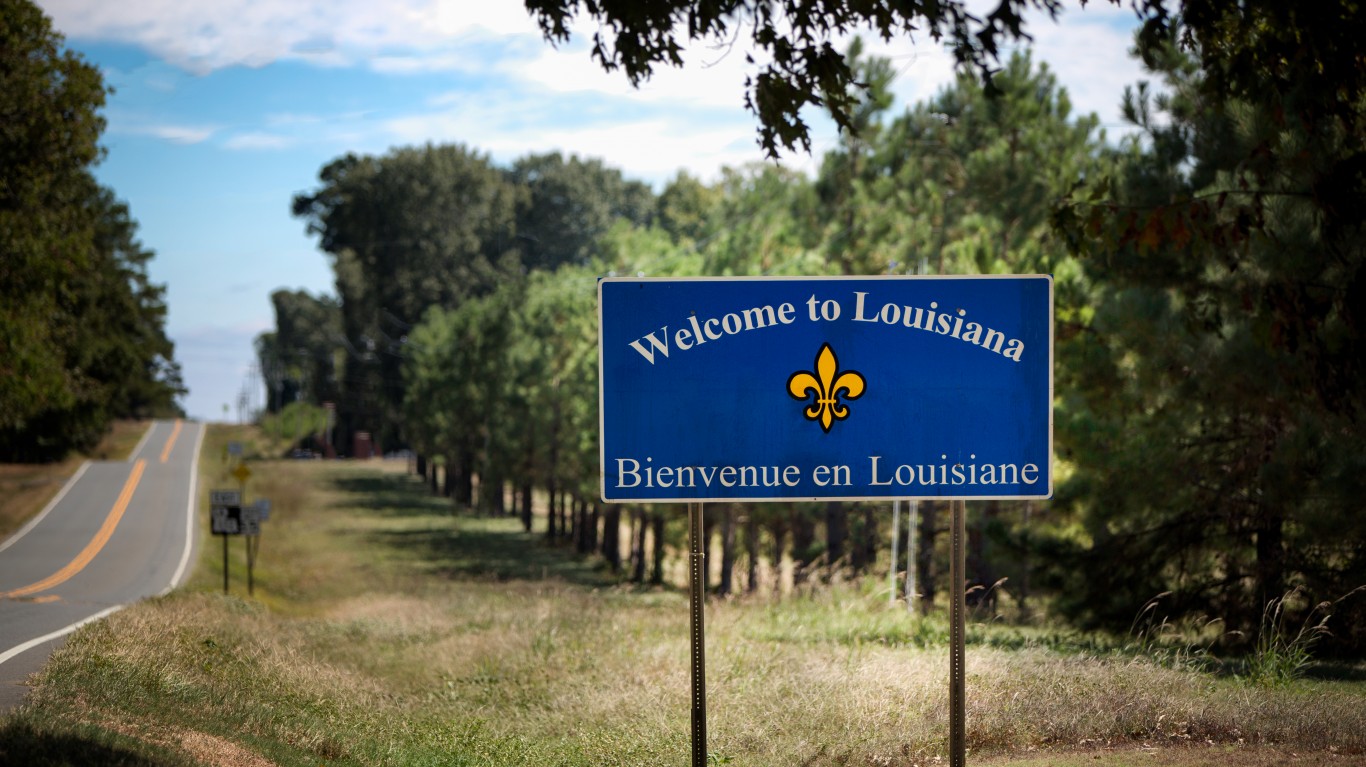
49. Louisiana
> 2018 unemployment: 4.9% (4th highest)
> Pension funded ratio: 65.1% (20th lowest)
> 1 yr. GDP growth: 2.6% (21st highest)
> Poverty rate: 18.6% (3rd highest)
> Moody’s credit rating and outlook: Aa3/Positive
An average of 4.9% of Louisiana’s workforce was out of a job in 2018, one of the highest unemployment rates among states and well above the comparable 3.9% national rate. The weak job market likely explains the greater likelihood of serious financial hardship in the state. Louisiana’s 18.6% poverty rate is higher than that of every other state except for New Mexico and Mississippi.
Crime tends to be more heavily concentrated in areas with worse economies, and Louisiana is a relatively dangerous state. There were 538 violent crimes for every 100,000 people in the state in 2018, well above the 369 per 100,000 national violent crime rate.
[in-text-ad-2]
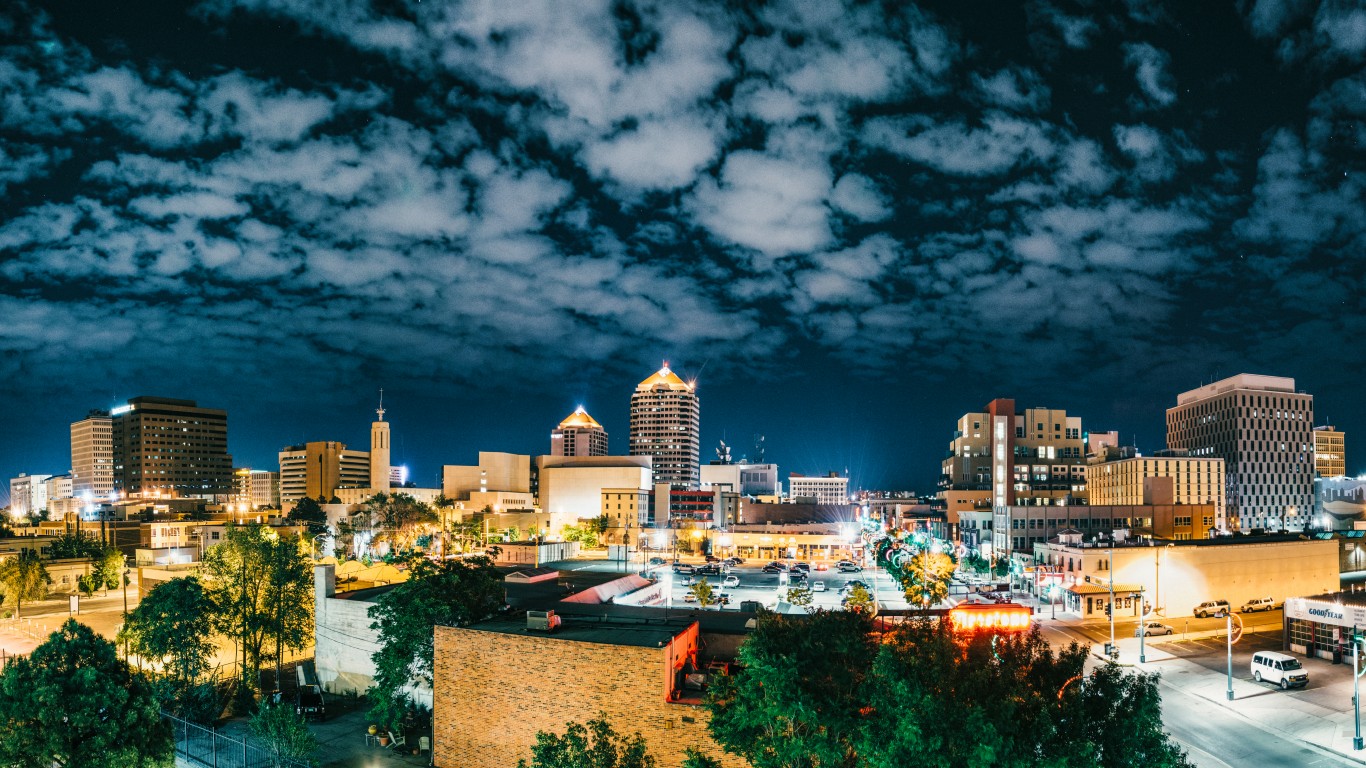
50. New Mexico
> 2018 unemployment: 4.9% (4th highest)
> Pension funded ratio: 62.5% (13th lowest)
> 1 yr. GDP growth: 2.5% (23rd highest)
> Poverty rate: 19.5% (2nd highest)
> Moody’s credit rating and outlook: Aa2/Stable
Based on an index of over a dozen socioeconomic measures, New Mexico ranks as the worst-run state in the country. New Mexico is one of the poorest states with 19.5% of the population living below the poverty line — the second highest poverty rate after only Mississippi. Due to the pervasiveness of serious financial hardship, 17.3% of state residents rely on SNAP benefits, formerly known as food stamps, the highest recipiency rate of any state. A stronger job market could go a long way to reduce SNAP dependence and poverty. New Mexico’s annual unemployment rate of 4.9% is one of the highest in the country, and well above the 3.9% national rate.
Crime tends to be more heavily concentrated in areas with poor economic conditions, and not only does New Mexico have one of the nation’s highest jobless rates, but it also has the second highest violent crime rate. There were 857 violent crimes for every 100,000 people in the state in 2018, more than double 369 per 100,000 national violent crime rate.
Methodology
To determine how well each state is run, 24/7 Wall St. constructed an index of 19 measures assessing state finances, economy, job market, and other various socioeconomic metrics. Data on population change due to net migration from July 2017 to July 2018 came from the Census Bureau’s Population Estimates Program and was included in the index. Data on the poverty rate, the percentage of adults 25 and over with at least a high school diploma, the percentage of the population without health insurance, and median household income for 2018 came from the U.S. Census Bureau’s American Community Survey and was included in the index. The change in median home value from 2017 to 2018 and the change in median home value from 2014 to 2018 were calculated from ACS data and were both included in the index.
State tax revenue figures for fiscal 2017 from the Census Bureau’s State & Local Government Finance tables were adjusted for population using 2017 population estimates and included in the index. Data on outstanding state debt in fiscal 2017, also from the Census Bureau, was adjusted for population using 2017 population estimates and included in the index. We also calculated state debt as a percentage of state revenue in fiscal 2017 and included it in the index. Census Bureau data on the total value of state exports in 2018, estimated using the state-based origin method, were adjusted for population using 2018 population estimates and included in the index.
Data on each state pension fund’s asset-to-liabilities ratio in fiscal 2017 came from The Pew Charitable Trusts and was included in the index. Data on each state’s rainy day fund balance as a percentage of general fund expenditures in fiscal 2018 came from the National Association of State Budget Officers and was included in the index. Credit ratings of each state’s general obligation bonds from Moody’s Investor Service, current as of Nov. 7, 2018, were included in the index.
Data on the number of violent crimes reported per 100,000 residents came from the FBI’s 2018 Uniform Crime Report and was included in the index. Data on the 2018 unemployment rate as well as the percentage change in labor force from 2014 to 2018 came from the Bureau of Labor Statistics’ Local Area Unemployment Statistics Program and both measures were included in the index. Data on the percentage growth in real GDP from 2017 to 2018 and real GDP per capita as of 2018 in chained 2012 dollars came from the Bureau of Economic Analysis and both measures were included in the index. All measures are for the most recent period available and were included in the index at equal weight.
The thought of burdening your family with a financial disaster is most Americans’ nightmare. However, recent studies show that over 100 million Americans still don’t have proper life insurance in the event they pass away.
Life insurance can bring peace of mind – ensuring your loved ones are safeguarded against unforeseen expenses and debts. With premiums often lower than expected and a variety of plans tailored to different life stages and health conditions, securing a policy is more accessible than ever.
A quick, no-obligation quote can provide valuable insight into what’s available and what might best suit your family’s needs. Life insurance is a simple step you can take today to help secure peace of mind for your loved ones tomorrow.
Click here to learn how to get a quote in just a few minutes.
Thank you for reading! Have some feedback for us?
Contact the 24/7 Wall St. editorial team.